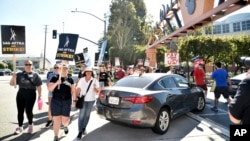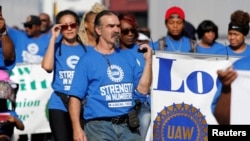The labor movement in the United States is having an unusually active moment, with as many as four high-profile strikes possible and a level of coordination among separate unions that experts say has been lacking in recent years.
In May, the Writers Guild of America, which represents film and television screenwriters, went on strike, followed last week by the Screen Actors Guild - American Federation of Television and Radio Artists (SAG-AFTRA). The combination of the two has brought production of film and television programs in the U.S. to a near-complete halt.
While labor action in Hollywood has garnered plenty of headlines, its day-to-day impact on average Americans has been limited. That will not be the case if two other major unions, both in contract negotiations right now, wind up on the picket lines.
The United Auto Workers union (UAW) is negotiating with automakers General Motors, Ford and Stellantis — the so-called Big Three — to try to avert a strike that could result in hundreds of thousands of autoworkers walking off the job. At the same time, the Teamsters union is in discussions with shipping giant United Parcel Service over its contract with delivery drivers. A strike by either or both would be deeply felt across the U.S.
Changing atmosphere
The labor movement in the United States has been in a period of protracted decline for several decades. In the mid-20th century, fully one-third of U.S. workers belonged to unions, and it was not uncommon in any given year to see thousands of strikes, with workers in the millions across multiple industries walking off the job for some period of time.
In 1974, at the peak of labor job actions, the federal government counted 6,074 individual strikes across the country, according to data gathered by Judith Stepan-Norris and Jasmine Kerrissey for their recent book, Union Booms and Busts: The Ongoing Fight Over the U.S. Labor Movement.
That began to decline in the 1980s, as legal protections for employers became stronger and the courts became less friendly to labor. Strikes increasingly ended with little or no benefits for the workers involved, while many lost a major source of income for the duration of their work stoppages. Union membership fell, and by 2014, the U.S. saw only 68 strikes in total. Today, union members make up only about 6% of working Americans.
Possible turnaround
Stepan-Norris, an emerita professor of sociology at the University of California-Irvine, told VOA there are multiple factors that appear to be animating the movement in 2023. She said the coronavirus pandemic and a trend of people leaving the workforce, called by many the “Great Resignation,” changed the dynamic significantly.
“That gave workers more power. You had more of a strong labor market with low unemployment,” Stepan-Norris said.
In addition, she said, they have had the example of some recent successful strikes. Last year, for example, academic workers led a massive strike against the University of California system, which resulted in major concessions in workers’ favor.
“Other workers are looking around and seeing that these strikes are starting to show some progress for people, and so other workers are getting a taste that they can do it, too,” she said. “Not to say that any of these new strikes are directly related to that — it's just sort of the atmosphere [of success] that surrounds them.”
Horizontal solidarity
Susan Schurman, who teaches labor studies and employment relations at Rutgers University, told VOA that in recent labor actions, she has seen a dynamic at play that has not been present recently: cross-union cooperation.
“The last time the Writers Guild went on strike, SAG-AFTRA didn't even show up,” Schurman said. “This time, I went to a couple of rallies in New York and the stage actors — Actors Equity — were there. The stagehands [the International Alliance of Theatrical Stage Employees] were there. The Teamsters were there. The Communication Workers [of America] were there. The building trades were there.
“We call this ‘horizontal labor solidarity’ across unions,” Schurman said. “This is when labor really makes gains. It's important that you have what we call ‘vertical solidarity,’ within your own union. You have to have that in order to engage in a strike. But it's not enough. You have to have the support of other unions.”
Horizontal solidarity was commonplace in the mid-20th century, she said, but has not been a notable factor in labor job actions in several decades.
“We have not seen that, like we're seeing this summer, in a very long time,” she said.
Autoworkers dispute
The UAW has a long history of striking in order to achieve better contracts for its members, and the current contracts with GM, Ford and Stellantis are all scheduled to expire in September.
Shawn Fain, the leader of the UAW, announced last week that his 160,000 members are prepared to put down their tools and that blame for any work stoppage will lie with the companies’ management.
“If the Big Three don’t give us our fair share, then they’re choosing to strike themselves, and we’re not afraid to take action,” he told reporters last week.
In a sign of how acrimonious the discussions have become, Fain broke with tradition and refused to meet company executives for a public handshake as negotiations got under way, as other UAW leaders have done in the past.
The automakers themselves have said they want to reach a deal but point out that they are trying to remake their companies for a world in which electric vehicles are expected to replace many of the gasoline-powered cars and trucks they currently produce. They warn that the transition will lead to inevitable disruption for their workforce.
Teamsters and UPS
The Teamsters union represents 340,000 UPS workers poised to strike on August 1. The contract negotiations, which broke down in early July and restarted just this week, are focused on compensation for workers.
One key point is that as the job market has tightened over the past year, the company has been forced to raise the starting salaries it offers in order to attract more workers. However, it did not also raise the wages of many of its more experienced workers. This means that some UPS employees with years of seniority are earning wages equivalent to those of new hires.
A strike by UPS workers could be damaging economically, with the think tank Anderson Economic Group estimating that a 10-day stoppage would cost upward of $7 billion when workers’ lost pay, the company’s lost profits and damage to UPS customers are combined.
In a statement that accompanied the announcement that it would return to the bargaining table, the delivery company emphasized the need for a prompt resolution to the problem.
“We are prepared to increase our industry-leading pay and benefits, but need to work quickly to finalize a fair deal that provides certainty for our customers, our employees and businesses across the country,” it said.













